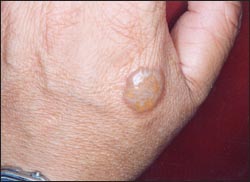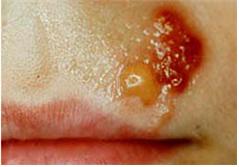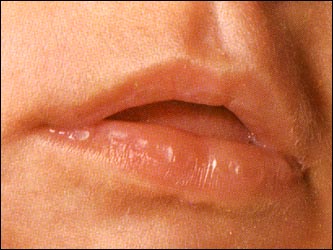물집(피부 물집, 피부에 물집이 잡혔을 때/수포, 포진) Blister, Skin blister, Bulae, Vesicles
물집(피부 물집, 수포, 포진)의 개요 및 원인
-
피부에 생긴 물집을 수포, 또는 포진이라 한다.
-
물집은 급성으로 생길 수도 있고 만성으로 생길 수도 있고 여러 가지 원인으로 생길 수 있다.
-
다음과 같은 경우, 물집이 급성으로 생길 수 있다.
① 뜨거운 물이나 불로 2도 이상 열화상을 입었을 때 생길 수 있는 화상성 물집
② 어떤 물체에 피부가 심하게 문질러서 생긴 마찰상 물집
③ 수두나 헤르페스바이러스 감염 등 바이러스 감염병으로 생기는 물집
④ 농가진 등 박테리아 감염병으로 생긴 물집
⑤ 유전성 질환
⑥ 2도 이상 동상
⑦ 옻 접촉성 피부염
⑧ 모기 등 곤충에 물림
⑨ 화학물질 접촉성 피부염
⑩ 다발 삼출성 홍반 (Erythema multiforme exudativum)
⑪ 포도상 구균성 열탕성 피부염 (포도알 구균성 열탕성 피부염/Staphylococcal scalded skin syndrome/SSSS)
⑫ 수족구병 (Hand,foot and mouth disease/HFMD)
⑬ 매독 (Syphilis)
⑭ 포도알균[구균]성 화상[열상]피부 증후군(포도상 구균성 열탕성 피부염)
⑮ 만성 수포성 피부병(Chronic bullous dermatosis)
⑯ 수포성 표피박리증 (Epydemolysis bullosa)
⑰ 천포창(펨피구스) (Pemphigus)
⑱ 유사 천포창(펨피고이드) (Pemphigoid)
⑲ 편평 태선 (Lichen planus)
⑳ 선천성 각화부전증 (Dyskeratosis congenital)
㉑ 크론 병 (Crohn’s disease)
㉒ 셀리악 병(Celiacs disease)
㉓ 장병성 선단피부염 (Acrodermatitis enteropathica)
㉔ 베체트 병 (Behcet’s disease)
㉕ 전신 홍반성 낭창 (Systemic lupus erythematosus/SLE)
㉖ 포르피리아(포르피리아증) (Porphyria)
㉗ 콕사키바이러스 감염 (Coxsackievirus infection)
㉘ 식물성 광 피부염 (Phytophotodermatitis)
-
그 외 다른 여러 원인으로 인해 피부에 물집이 잡힐 수 있다.
-
요약하면 불, 뜨건 물체, 화학물질, 햇볕, 끓는 물, 피부 외상, 박테리아 감염, 바이러스 감염, 2도 이상 동상, 유전, 그 외 다른 원인으로 피부에 물집이 잡힐 수 있다(화상 참조). 참조문헌 NEJM October 2008 p.1718

▴ 사진 415. 2도 화상이나 벌레에 물리거나 쏘였을 때 물집이 잡힐 수 있다. Copyright ⓒ 2011 John Sangwon Lee, MD., FAAP

▴ 사진 416. 헤르피스바이러스 피부감염으로 인한 물집(Cold blisters). Copyright ⓒ 2011 John Sangwon Lee, MD., FAAP

▴ 사진 417. 신생아의 아래 입술에 생긴 흡입성 수포(물집). Copyright ⓒ 2011 John Sangwon Lee, MD., FAAP

▴사진418. 옻나무접촉으로 인한 접촉성 피부염으로 생긴 물집. Copyright ⓒ 2011 John Sangwon Lee, MD., FAAP
물집(피부 물집, 수포, 포진)의 치료
-
물집의 원인과 물집의 중증도에 따라 치료한다.
-
특히, 박테리아 감염병이나 바이러스 감염병으로 피부에 생긴 물집은 의사의 지시에 따라 치료한다.
-
화상이나 외상으로 생긴 물집을 덮고 있는 피부에 세균 감염이 생기지 않게 예방하고 물집 속 체액에 박테리아 감염이 생기지 않게 예방 치료를 한다.
-
혈관 내 단백질, 전해질, 체액 등이 화상으로 생긴 물집 속으로 나온다. 물집이 터지면 단백질, 전해질, 체액 등이 체외로 소실된다. 단백질, 전해질, 체액 등이 소실되지 않게 치료해야 한다.
-
의사의 지시에 따라 화상으로 생긴 물집이 곪지 않은 한 물집을 터트리지 말고 그대로 놓고 관찰한다.
-
화상으로 생긴 물집을 덮고 있는 피부가 괴사되지도 않고 재생될 수 있다.
-
화상이나 외상으로 생긴 물집이 터지지 않았을 때는 물집에 박테리아 감염이 생기지 않도록 물집을 터트리지 말고 실버데인 크림 등 화상 치료용 크림을 바르거나 무균 거즈나 일회용 밴드 에이드로 물집을 덮어 치료할 수 있다.
-
의사의 지시에 따라, 화학물질 접촉으로 생긴 물집을 물로 깨끗이 씻고 물집을 터트리지 말고 그대로 두고 관찰할 수 있다.
-
불결하고 터진 물집은 비눗물로 깨끗이 씻은 후 베타다인액 살균제나 다른 종류의 살균제로 살균치료를 할 수 있다. 의사의 지시에 따라 치료한다.
-
물집이 이미 터졌거나, 물집을 덮었던 피부가 괴사됐거나 물집이 곪았을 때는 소독된 가위로 물집을 덮은 피부를 조심스럽게 잘라낸 후 물집이 있는 상처를 무균 거즈로 덮고 의사의 지시에 따라 치료한다.
-
물집이 터졌지만 물집이 불결하지 않고 박테리아 감염이 되지 있지 않았을 때는 터진 물집을 베타다인액 살균제나 다른 종류의 살균제로 살균을 한 후 일회용 밴드에이드나 무균 거즈로 덮고 관찰 치료를 할 수 있다.
-
물집의 원인이 무엇인지 모르거나, 물집을 어떻게 치료할지 잘 모르면 병원 응급실이나 단골 소아청소년 의사의 지시에 따라 치료한다.
-
물집이 심할 때는 병원으로 환아를 곧 데리고 간다.
-
물집이 생기면 권장한 대로 파상풍 백신 예방접종을 받는다.
-
물집이 생긴 피부가 붓고 아프면 얼음물 찜질이나 찬물 찜질로 치료 하든지 타이레놀이나 모트린 등 경구용 진통제로 진통시킨다.
-
터진 물집에 박테리아 감염이 생겨 물집이 곪으면 적절한 항생제로 치료받는다.
-
그 외 .
Blister, Skin blister, Bulae, Vesicles 물집(피부 물집, 피부에 물집이 잡혔을 때/수포, 포진)
Blister, Skin blister, Bulae, Vesicles Overview and causes of blisters (skin blisters, blisters, herpes)
- Blisters on the skin are called blisters
- Blisters can occur acutely, chronically, or can be caused by several causes.
- In the following cases, blisters may occur acutely.
- ① Burning blisters that may occur when you suffer a thermal burn of 2 degrees or more with hot water or fire.
- ② Abrasive blisters caused by severe rubbing of the skin on an object
- ③ Blisters caused by viral infections such as chickenpox or herpes virus infection
- ④ Blisters caused by bacterial infectious diseases such as impetigo
- ⑤ hereditary diseases
- ⑥ Bronze statue of 2 degrees or higher
- ⑦ Contact dermatitis of lacquer
- ⑧ Bited by insects such as mosquitoes
- ⑨ Chemical contact dermatitis ⑩ Multiform exudative erythema (Erythema multiforme exudativum)
- ⑪ Staphylococcal scalded skin Syndrome/SSSS
- ⑫ Hand, foot and mouth disease/HFMD
- ⑬ Syphilis
- ⑭ Staphylococcal [coccus]-related burns [heat burns] skin syndrome (staphylococcal hot spring dermatitis)
- ⑮ Chronic bullous dermatosis
- ⑯ Epydemolysis bullosa
- ⑰ Pemphigus
- ⑱ Similar pemphigoid (Pemphigoid)
- ⑲ Lichen planus
- ⑳ Dyskeratosis congenital
- ㉑ Crohn’s disease ㉒ Celiacs disease
- ㉓ Acrodermatitis enteropathica
- ㉔ Behcet’s disease Systemic lupus erythematosus/SLE
- ㉖ Porphyria
- ㉗ Coxsackievirus infection
- ㉘ Phytophotodermatitis
- There are many other causes that can cause blisters on your skin.
- In summary, blisters may be caught on the skin due to fire, hot objects, chemicals, sunlight, boiling water, skin trauma, bacterial infection, virus infection, frostbite above 2 degrees, genetics, and other causes (see burn). References:NEJM October 2008 p.1718

- ▴ Photo 415. When 2nd degree burns or insect bites or stings, blisters may be caught. Copyright ⓒ 2011 John Sangwon Lee, MD., FAAP

- ▴ Photo 416. Cold blisters caused by skin infection with herpis virus. Copyright ⓒ 2011 John Sangwon Lee, MD., FAAP

- ▴ Photo 417. Inhalable blisters (blisters) on the lower lip of a newborn baby. Copyright ⓒ 2011 John Sangwon Lee, MD., FAAP

- ▴Picture 418. Blisters resulting from contact dermatitis caused by contact with poison ivy. Copyright ⓒ 2011 John Sangwon Lee, MD., FAAP
Treatment of blisters (skin blisters, blisters)
- Treatment depends on the cause of the blister and the severity of the blister. In particular, treat blisters on the skin caused by bacterial or viral infections according to the doctor’s instructions.
- Prevent bacterial infection from developing on the skin covering the blister caused by burns or trauma, and prevent bacterial infection from developing the fluid in the blister. Proteins, electrolytes, and body fluids in blood vessels come out into blisters caused by burns.
- When a blister bursts, proteins, electrolytes, and body fluids are lost outside the body.
- It should be treated so that proteins, electrolytes, body fluids, etc. are not lost. Do not burst the blister and observe it as it is, unless the burned blister is festered according to the doctor’s instructions.
- The skin covering the blister from the burn can be regenerated without necrosis. If the blister caused by burns or trauma does not burst, you can treat the blister by applying a burn treatment cream such as silverdane cream or covering the blister with sterile gauze or a disposable band-aid instead of popping the blister to prevent bacterial infection.
- According to the doctor’s instructions, blisters caused by contact with chemicals can be washed thoroughly with water and observed without popping the blisters.
- Unclean and bursting blisters can be cleaned with soapy water and treated with betadine disinfectant or other types of disinfectant.
- Treat as directed by your doctor.
- If the blister has already burst, the skin covering the blister is necrotic, or the blister is festered, carefully cut the blister-covered skin with sterile scissors, cover the blistered wound with sterile gauze, and treat it according to the doctor’s instructions.
- If the blister is burst but the blister is not dirty and there is no bacterial infection, the blister can be sterilized with betadine solution disinfectant or another type of disinfectant, and then covered with a disposable band-aid or sterile gauze for observational treatment.
- If you do not know what the cause of the blister is, or do not know how to treat the blister, treat it according to the hospital’s emergency room or a regular pediatrician’s instructions.
- If the blister is severe, take the child to the hospital soon. If blisters develop, get the tetanus vaccine as recommended.
- If blistered skin is swollen and painful, treat it with ice or cold water, or relieve pain with oral pain relievers such as Tylenol or Motrin.
- If the blister has become festering due to a bacterial infection in the ruptured blister, seek treatment with appropriate antibiotics.
출처 및 참조문헌
Emergency Medical Service for Children, By Ross Lab. May 1989. p.10
Emergency care, Harvey grant, and Robert Murray
Emergency Care Transportation of Sick and Injured American Academy of Orthopaedic Surgeons
Emergency Pediatrics A Guide to Ambulatory Care, Roger M. Barkin, Peter Rosen
Quick Reference To Pediatric Emergencies, Delmer J. Pascoe, M.D., Moses Grossman, M.D. with 26 contributors
Manual of Emergency Care
응급환자관리 정담미디어
소아가정간호백과-부모도 반의사가 되어야 한다, 이상원 저
The pregnancy Bible. By Joan stone, MD. Keith Eddleman, MD
Preparation for Birth. Berverly Savage and Dianna Smith
임신에서 신생아 돌보기까지. 이상원
Breastfeeding. by Ruth Lawrence and Robert Lawrence
The Johns Hopkins Hospital, The Harriet Lane Handbook, 18th edition
Red book 29th-31st edition 2021
Nelson Text Book of Pediatrics 19th-21st Edition
Infectious disease of children, Saul Krugman, Samuel L Katz, Ann A. Gershon, Catherine Wilfert
The Harriet Lane Handbook 19th Edition
Growth and Development of Children, George H. Lowrey 8th edition
소아과학 대한교과서
제1권 소아청소년 응급의료 참조 문헌과 출처
Other
Copyright ⓒ 2015 John Sangwon Lee, MD., FAAP
“부모도 반의사가 되어야 한다”-내용은 여러분들의 의사로부터 얻은 정보와 진료를 대신할 수 없습니다.
“The information contained in this publication should not be used as a substitute for the medical care and advice of your doctor. There may be variations in treatment that your doctor may recommend based on individual facts and circumstances. “Parental education is the best medicine.”